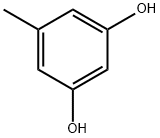????
|
|
???? ??
- ???
- 106-112 °C(lit.)
- ?? ?
- 290 °C
- ??
- 1.2900
- ???
- 1.4922 (estimate)
- ???
- 159 °C
- ?? ??
- Store at <= 20°C.
- ???
- 80g/L
- ?? ?? (pKa)
- 9.56±0.10(Predicted)
- ??? ??
- ??? ?? ?? ??
- ??
- ??? ???? ??? ????
- ???
- 80g/L
- ??
- Air Sensitive
- Merck
- 14,6864
- BRN
- 1071903
- ???
- ???
- InChIKey
- OIPPWFOQEKKFEE-UHFFFAOYSA-N
- LogP
- 1.221 (est)
- CAS ??????
- 504-15-4(CAS DataBase Reference)
??
- ?? ? ?? ??
- ?? ? ???? ?? (GHS)
| ??? ?? | Xn | ||
|---|---|---|---|
| ?? ???? ?? | 22-36/37/38-41-37/38-20/21/22 | ||
| ????? | 22-26-36-37/39 | ||
| ????(UN No.) | 2811 | ||
| WGK ?? | 3 | ||
| RTECS ?? | VH2100000 | ||
| TSCA | Yes | ||
| ???? | III | ||
| HS ?? | 29072900 | ||
| ?? | LD50 orally in Rabbit: > 2000 mg/kg LD50 dermal Rabbit > 5000 mg/kg | ||
| ???? ?? | KE-23458 |
???? C??? ??, ??, ??
??? ??
pink-grey to pink-brown powder or crystals.??
Orcinol can be used to synthesize:Orcinol-containing azacryptands for use in optical amplifiers and light-emitting devices.
Ternary co-crystal with 4,4′-bipyridine.
Low-density carbon aerogels in the presence of formaldehyde.
PEG-orcinol coumarins with potent tyrosinase inhibitory activity.
?? ??
Orcinol is found in many lichen species and It is used as an analytical reagent for pentoses, lignin, beet sugar, saccharoses, arabinose, and diastase. The orcinol assay was used for the direct assay of the number of glycolipids presents in the sample. The orcinol reagent was prepared by adding concentrated sulphuric acid, H2SO4 (98% w/w) and 0.19% orcinol (3,5-dihydroxytoluene) to distilled water.??
ChEBI: Orcinol is a 5-alkylresorcinol in which the alkyl group is specified as methyl. It has a role as an Aspergillus metabolite. It is a 5-alkylresorcinol and a dihydroxytoluene.?? ??
Orcinol has been isolated from numerous lichen fungi (Robiquet, 1829) and can be synthesized by decarboxylation of orsellinic acid in Umbilicaria papulosa and Gliocladium roseum (Pettersson, 1965; Mosbach and Ehrensvard, 1966).Orcinol was first prepared by dehydroacetic acid, a conversion that involved ring-opening of the pyrone to a triketone. This early experiment helped establish the rich condensation chemistry of polyketides. It can be obtained by fusing extract of aloes with potash, followed by acidification.
US3865884A: Preparation of orcinol
???? ??
Orcinol is a compound obtained from DHA which can mimic the biogenetic synthesis of phenolic compounds.Orcinol is a polyketide synthase-derived phenol that has been found in F. graminearum and has diverse biological activities. It scavenges DPPH radicals (IC50 = 2.93 mM). Orcinol (2.5 and 5 mg/kg) increases the number of entries into and percentage of time spent in the open arms of the elevated plus maze in mice, indicating anxiolytic-like activity. It has also been used in the colorimetric detection of carbohydrates.
Safety Profile
Poison by subcutaneous and intravenous routes. Moderately toxic by ingestion and intraperitoneal routes. Mildly toxic by skin contact. When heated to decomposition it emits acrid smoke and irritating fumes.Purification Methods
Crystallise orcinol from CHCl3/*benzene (2:3). See hydrate in previous entry. [Beilstein 6 H 882, 6 IV 5892.]???? ?? ?? ? ???
???
?? ??
???? ?? ??
???( 468)?? ??
| ??? | ?? | ??? | ?? | ?? ? | ?? |
|---|---|---|---|---|---|
| Zhengzhou Anbu Chem Co.,Ltd | +86-0371-88006763; +8615988602810 |
sales@anbuchem.com | China | 2998 | 58 |
| Hebei Chuanghai Biotechnology Co., Ltd | +86-15531157085; +8615531157085 |
abby@chuanghaibio.com | China | 8807 | 58 |
| Henan Fengda Chemical Co., Ltd | +86-371-86557731 +86-13613820652 |
info@fdachem.com | China | 20229 | 58 |
| Xiamen Work-For-World Medicine Co.,Ltd. | +8615921822462 |
co@wfwmed.com | China | 446 | 58 |
| Capot Chemical Co.,Ltd. | +86-(0)57185586718 +86-13336195806 |
sales@capot.com | China | 29730 | 60 |
| Shanghai Bojing Chemical Co.,Ltd. | +86-86-02137122233 +8613795318958 |
bj1@bj-chem.com | China | 299 | 55 |
| Henan Tianfu Chemical Co.,Ltd. | +86-0371-55170693 +86-19937530512 |
info@tianfuchem.com | China | 21627 | 55 |
| career henan chemical co | +86-0371-86658258 +8613203830695 |
sales@coreychem.com | China | 29856 | 58 |
| Chengdu Biopurify Phytochemicals Ltd. | +86-28-82633860; +8618080483897 |
sales@biopurify.com | China | 3772 | 58 |
| Hubei Jusheng Technology Co.,Ltd. | 18871490254 |
linda@hubeijusheng.com | CHINA | 28172 | 58 |







